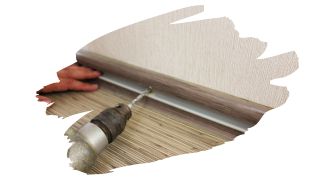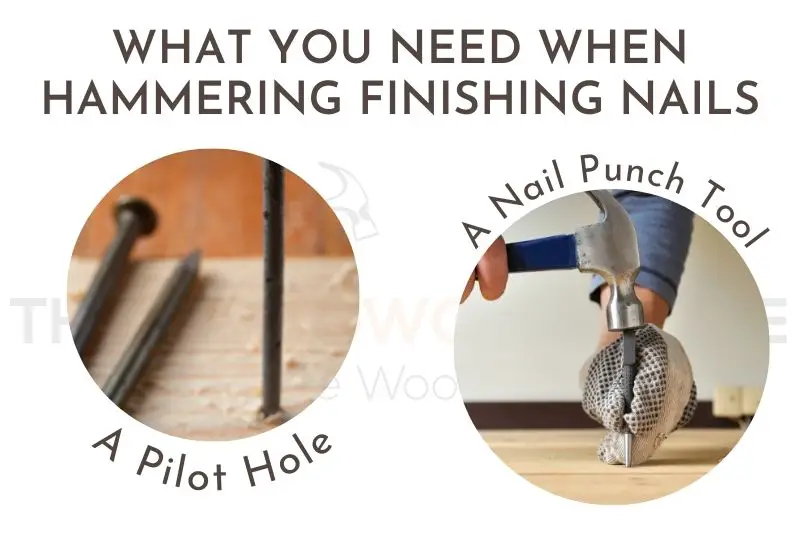Let’s say you’re currently thinking about having your floors redone. And you’ve also thought about giving those dated baseboards a fresh new look.
And yet, traditional quarter round molding doesn’t quite match with the new decor you’ve had in mind. So, what can you use instead of quarter round?
Well, in this post, you’ll learn why quarter round molding is so often used on baseboard installations. We also explain the difference between Cove Molding and Quarter Round. And keep reading to discover the best type of nail for fastening Cove Molding.

This post may contain affiliate links to products that we receive a commission for (at no additional cost to you). Learn more here.
What Is the Point Of Quarter Round Molding?
Quarter Round Molding is there to help mask any floor gaps showing at the bottom of baseboards.
It’s an easy way to hide other imperfections, nicks, and even nail puncture holes.
Is Quarter Round Molding Always Necessary?
Not always. It’s simply one of the easiest ways to cover over floor gaps. You can use other methods to cover off the space at the bottom of baseboards.
But, quarter rounds prevent dirt from gathering underneath the baseboard and trim. And it also makes the entire installation appear seamless from floor to wall.
Related Post: Should You Use Brad Nails Or Finish Nails For Quarter Round Molding?
So What Can I Use Instead Of Quarter Round Molding?
The most popular alternative to Quarter Rounds is something called a Shoe Molding. Shoe Molding (also referred to as a base shoe) does the same job as a Quarter Round.
However, base shoes are shaped slightly differently, and do not have the uniform quarter radius shape of Quarter Rounds.
What About Cove Molding? What Is Cove Molding Used For?
Well, Cove Moldings do exactly what Quarter Rounds do. Except Cove Moldings cover wall/ceiling gaps, rather than wall/floor gaps.
Also, while Quarter Rounds have a convex shape curving outward, Cove Moldings have a concave shape, and they curve inward.
And Can You Use Cove Molding For Your Baseboard (Instead Of Quarter Rounds)?
You can easily substitute cove moldings for quarter round strips.
However, your vacuum cleaner may catch and scrape against it a little more, when you clean. Still, it is not noticeably more difficult to vacuum around it.
And What Kind Of Nails Should You Use To Install Cove Molding?
You’ll want to use a two inch long finishing nail to affix this molding to the baseboard. Finishing nails have great holding power, and they can even be used to nail floorboards into place.
Nonetheless, it is worth mentioning that finishing nails can leave noticeable nail holes behind on that Cove Molding. Enough so that you might need to use putty to fill them in — if you want a wholly seamless looking installation.
Related Post: What’s The Best Nailer For MDF Trim? (Everything You Need To Know)
What About Brad Nails? Can I Use Brad Nails To Install Cove Molding?
Well, brad nails are shorter than finishing nails. So, they don’t have the same holding power.
These nails are better suited for nailing light thin wooden crafts. And they’re sometimes used for keeping wood glue joints together, while you wait for the adhesive to dry.
If that Cove Molding is fairly thin, an 18 gauge Brad nail will keep that strip of wood in place. However, your best option will almost always be to use a 15 gauge or 16 gauge finishing nail.
Related Post: Best Cordless Brad Nailers [Reviewed]
Can You Simply Hammer Finishing Nails Into Cove Molding?
You don’t need to use a power tool to fasten finishing nails. But, if you try to hammer directly onto these fairly slender fasteners, you’ll end up bending them.
That’s why you need to use a handy little tool called a ‘nail punch’. This tool makes it very simple for you to hammer small finishing nail heads dead center.

You can learn more by checking out our post right here on The Woodwork Place: Why Finishing Nails Keep Bending (And What You Can Do To Fix It).
In that article we cover everything you can do to make sure you punch finishing nails straight into cove molding.
To Wrap Up, Here Are The 3 Key Takeaways From This Post…
- 1). Quarter Round Molding is designed to hide away baseboard floor gaps.
- 2). You can use other types of molding to perform the same task, such as Shoe Molding and Cove Molding.
- 3). Ideally, use Finishing nails to affix Cove Molding. Although Brad nails can be used to nail very thin strips of Cove molding.
